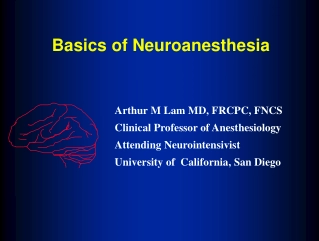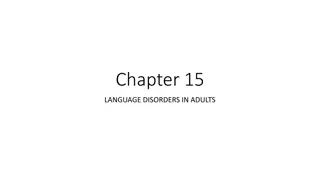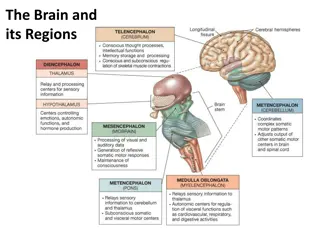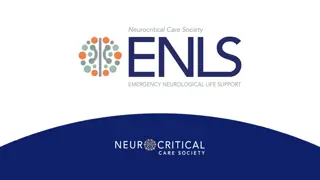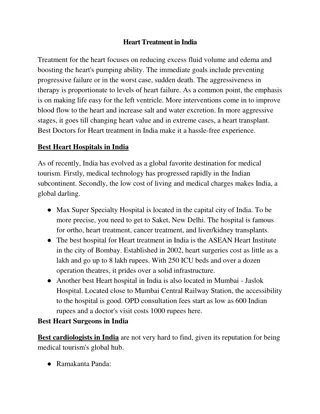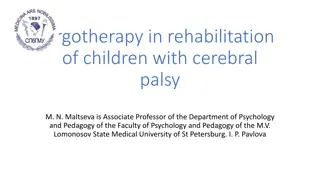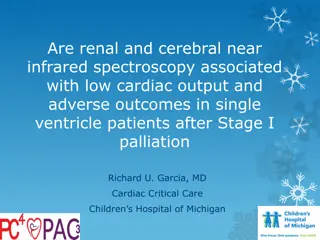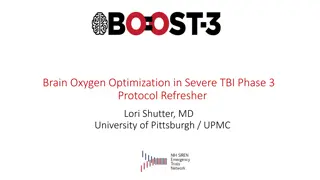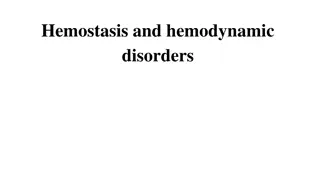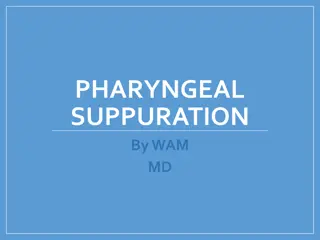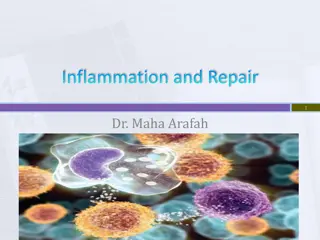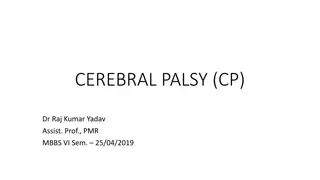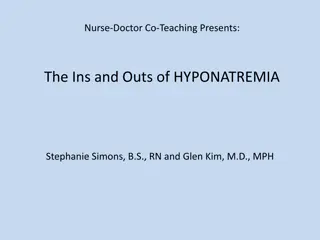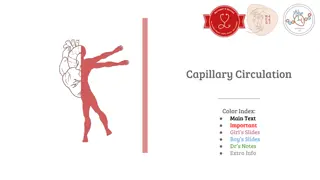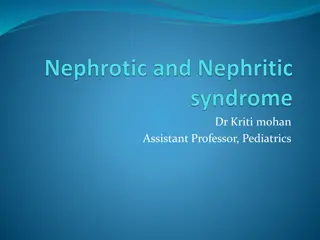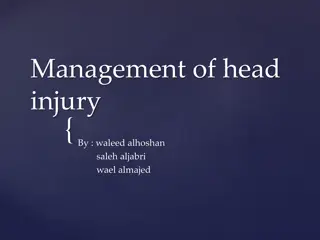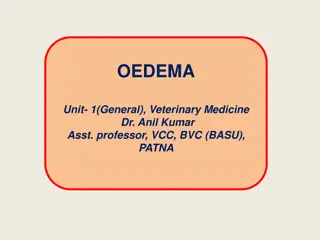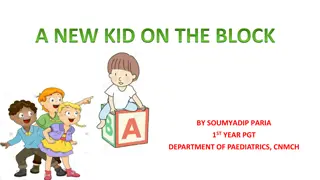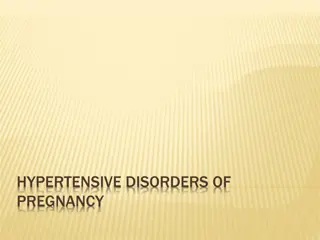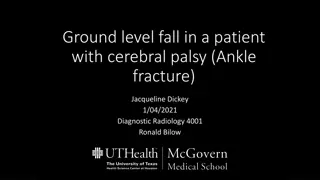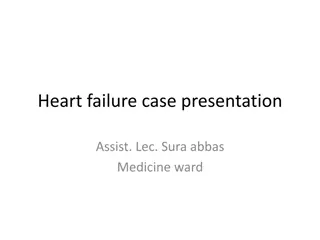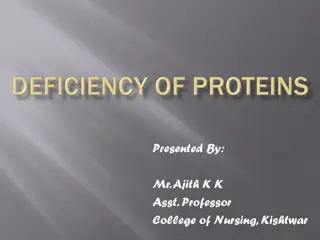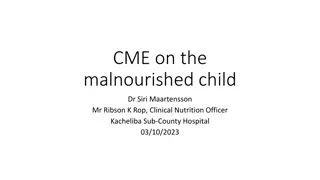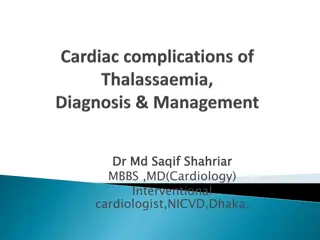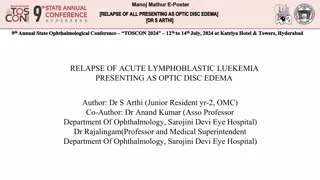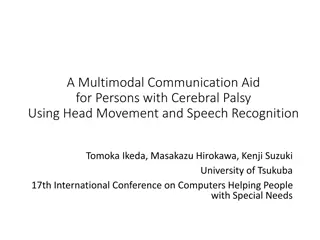Basics of Neuroanesthesia
The intricate mechanisms involved in regulating cerebral blood flow during neuroanesthesia, including factors like pressure autoregulation, metabolic control, and the influence of inhaled agents. Discover the critical interplay between flow and metabolism coupling in maintaining optimal brain perfus
0 views • 44 slides
Understanding Neurogenic Speech and Language Disorders in Adults
This chapter provides insight into language disorders in adults, including types of aphasia, causes such as toxins, traumatic brain injury, brain tumors, and strokes. It discusses cerebral hemorrhage, occlusive strokes, ischemic stroke, transient ischemic attacks, and cerebral thrombosis. The conten
1 views • 34 slides
Explore the Fascinating World of the Brain and its Functions
Delve into the intricate structures and functions of the brain, from its regions to the cerebral lobes. Learn about the roles of the left and right hemispheres, essential sensory and motor areas, and the cerebral nuclei. Discover how the brain enables us to be conscious, control movements, and proce
4 views • 27 slides
Understanding Neuropsychological Assessment: Insights and Applications
Neuropsychological assessment plays a vital role in understanding brain-behavior relationships. This process involves determining cerebral functioning, identifying dysfunction, and assessing cognitive abilities through a combination of interviews, observational data, and testing. The assessment aids
3 views • 33 slides
Understanding Basic CT Perfusion Terms in Stroke Imaging
This educational content delves into fundamental concepts related to CT perfusion imaging in stroke evaluation. It covers key terms such as core infarct, penumbra, Time to Peak, Mean Transit Time, Cerebral Blood Volume, and more. The information includes definitions, descriptions, and the significan
6 views • 16 slides
Airway Management in Neurological Patients: ENLS Version 5.0
Explore the essentials of airway, ventilation, and sedation in neurological patients through the ENLS Version 5.0 content. Understand the challenges and goals of managing airways in critical situations such as trauma or respiratory distress. Learn about common indications for intubation and the impo
0 views • 37 slides
Explore the Structures and Functions of the Brain
Delve into the intricate world of the brain, learning about important structures like the hypothalamus and cerebral cortex. Discover how electrical impulses move through neurons and understand the dual nature of nervous impulses. Engage in activities to map brain functions and test your knowledge wi
1 views • 23 slides
Clinicopathological Conference - Medical Case Presentation Under Supervision of Prof. Dr. Irfan Ahmed
Sabir Ali, a 42-year-old male resident of Sadiqabad, presented with a month-long history of vomiting, decreased urine output, and altered consciousness. Known case of asthma, he experienced abdominal pain, diarrhea, and weight loss. Admitted for oliguria and pedal edema, he underwent hemodialysis. N
0 views • 30 slides
Heart Treatment in India
Treatment for the heart focuses on reducing excess fluid volume and edema and boosting the heart's pumping ability. The immediate goals include preventing progressive failure or in the worst case, sudden death. The aggressiveness in therapy is proportionate to levels of heart failure. As a common po
0 views • 2 slides
Understanding Ergotherapy in Cerebral Palsy Rehabilitation
Explore the role of ergotherapy in the rehabilitation of children with cerebral palsy, emphasizing the importance of early habilitation, continuous learning, and support strategies for individuals and families. Discover the challenges faced by parents and caregivers, the necessity for acceptance, an
1 views • 15 slides
Association of Renal and Cerebral Near-Infrared Spectroscopy with Adverse Outcomes in Single Ventricle Patients after Stage I Palliation
Study investigates the association between renal and cerebral near-infrared spectroscopy (NIRS) values and low cardiac output syndrome in single ventricle patients post Stage I palliation. Data from infants who underwent surgery between 2010-2019 is analyzed to determine correlations with adverse ou
0 views • 13 slides
Understanding the Structure and Function of the Cerebrum
Dive into the intricate details of the cerebrum, the largest part of the forebrain. Explore its parts including the cortex, medulla, basal ganglia, and lateral ventricle. Learn about the lobes, important sulci, and gyri. Understand the types of fibers in the cerebral medulla and their functions. Unr
1 views • 20 slides
Brain Oxygen Optimization in Severe TBI - Protocol Summary
In the severe traumatic brain injury (TBI) protocol, intracranial monitors measuring ICP and PbtO2 are placed within 12 hours of injury. Procedures include FiO2 challenges to check PbtO2 reliability and assess cerebral physiology. Challenges involving FiO2, MAP, and CO2 help guide ventilator setting
2 views • 27 slides
Global Nutrition Prevalence Rates in Children and Women
This content highlights the prevalence rates of acute malnutrition, severe acute malnutrition (SAM), moderate acute malnutrition (MAM), childhood stunting, acute malnutrition based on MUAC and edema, and acute malnutrition in pregnant and lactating women. The data is based on various criteria such a
9 views • 37 slides
Understanding Hemostasis and Hemodynamic Disorders in Health
Hemostasis is crucial for maintaining the health of cells and tissues by ensuring continuous circulation of water, oxygen, and nutrients while removing metabolic waste products. Factors controlling normal hemostasis include the integrity of blood vessel walls, blood content, platelet function, and l
0 views • 14 slides
Understanding Pharyngeal Suppuration and Abscesses
Pharyngeal suppuration and abscesses, such as peritonsillar abscess (Quinsy), parapharyngeal abscess, and retropharyngeal abscess, can present with symptoms like pain, fever, trismus, and neck swelling. Complications may include laryngeal edema and mediastinitis. Treatment involves systemic antibiot
1 views • 4 slides
Understanding Inflammation and Repair in Tissue Response
Inflammation is a crucial process in response to tissue injury, aiming to eliminate harmful agents and promote healing. It involves vascular changes, increased permeability, and the formation of edema. Repair follows inflammation, involving regeneration and fibroblastic tissue formation. While infla
0 views • 57 slides
Understanding Cerebral Edema: Causes, Treatments, and Pathophysiology
Cerebral edema is a life-threatening condition that can result from various factors such as trauma, infarction, hemorrhages, or tumors. This condition can lead to increased morbidity and mortality due to hemorrhage or herniation. New advances in understanding the pathophysiology of cerebral edema ha
1 views • 28 slides
Understanding Cerebral Palsy: Causes, Risk Factors, and Pathology
Cerebral Palsy (CP) is a clinical syndrome characterized by motor dysfunction and non-progressive brain damage affecting an immature developing brain. This article explores the definition, risk factors during prenatal, natal, and postnatal periods, and the pathology associated with CP, including dif
1 views • 38 slides
Understanding Hyponatremia: Clinical Presentation and Management
Nurse-Doctor Co-Teaching presents a case study of a 63-year-old woman with hyponatremia, discussing key observations and factors relevant to her condition. The session aims to simplify the complexities of hyponatremia by reviewing the importance of correction rates, providing a framework for patient
0 views • 15 slides
Understanding Protein Energy Malnutrition (PEM): Signs, Symptoms, and Treatment
Protein Energy Malnutrition (PEM) is a serious nutritional disorder resulting from a deficiency of macronutrients, energy, and protein in the diet. This article explores the different types of PEM, focusing on clinical forms like Kwashiorkor, Marasmus, and Marasmic Kwashiorkor. Detailed descriptions
0 views • 20 slides
Association of Renal and Cerebral Near Infrared Spectroscopy with Low Cardiac Output in Single Ventricle Patients
Near-infrared spectroscopy (NIRS) has been studied in infants after Stage I palliation surgery to assess its association with low cardiac output and adverse outcomes. This retrospective study investigated postoperative cerebral and renal NIRS values in infants with single ventricle physiology. Resul
0 views • 13 slides
Understanding Capillary Circulation in the Vascular System
This content delves into the intricate components of capillary circulation, covering topics such as microcirculation, types of capillaries, regulation of flow in capillary beds, and the formation of interstitial fluid. It also discusses edema, lymphatics, diffusion, and filtration processes. The vis
4 views • 28 slides
Understanding Nephrotic Syndrome in Pediatric Patients
Nephrotic syndrome is a significant chronic disease in children characterized by heavy proteinuria, hypoalbuminemia, edema, and hyperlipidemia. It is primarily idiopathic, with secondary causes including SLE, sickle cell disease, and infections. The pathophysiology involves glomerular dysfunction le
0 views • 43 slides
Understanding Nephritis: Causes, Symptoms, and Subtypes
Nephritis is a serious medical condition characterized by inflammation of the nephrons in the kidneys. This inflammation can lead to various subtypes such as glomerulonephritis and interstitial nephritis, each with its own causes and symptoms. Common symptoms of nephritis include edema, changes in u
0 views • 26 slides
Obstetric Patient with Concerns for Weight Gain and Hypertensive States in Pregnancy
A 30-year-old gravid 6 para 4 patient at 36 weeks and 5 days presents with weight gain, headaches, epigastric discomfort, nausea, and swelling. Symptoms started a week ago, with notable pitting edema in hands and feet, blurry vision, and epigastric pain. Past medical history includes chronic hyperte
4 views • 11 slides
Acute Malnutrition - Fluid Management and Treatment Overview
Acute malnutrition, particularly severe acute malnutrition (SAM), requires careful fluid management and a structured treatment approach involving stabilization, transition, and rehabilitation phases. This condition results from inadequate dietary intake or acute infections, leading to severe wasting
0 views • 23 slides
Comprehensive Management of Head Injury: Overview and Key Strategies
Head injuries pose a significant threat to morbidity and mortality, with causes ranging from motor accidents to child abuse and falls. Understanding the epidemiology and pathophysiology of head injuries is crucial for effective management. Primary and secondary brain injuries necessitate immediate c
0 views • 42 slides
Understanding Edema in Veterinary Medicine
Edema, an excessive accumulation of fluid in tissue spaces, is caused by disruptions in fluid exchange mechanisms. It can result from various factors such as increased hydrostatic pressure, decreased plasma oncotic pressure, increased capillary permeability, and obstruction to lymphatic flow. Differ
0 views • 10 slides
Case Study: A New Kid on the Block - Pediatric Presentation
An 11-year-old girl presented with a four-month history of fever, three months of generalized weakness and body ache, and a recent weight loss. Physical examination revealed pallor, edema, generalized tenderness, lymphadenopathy, and telangiectatic rash. Vitals showed elevated respiratory and heart
0 views • 27 slides
Understanding Hypertensive Disorders of Pregnancy
Hypertensive disorders of pregnancy encompass conditions like pregnancy-induced hypertension, chronic hypertension, pre-eclampsia, eclampsia, and imminent eclampsia. Pre-eclampsia, affecting around 3% of pregnancies, poses risks such as elevated BP, fluid retention, and various clinical manifestatio
0 views • 27 slides
Ankle Fracture in a Patient with Cerebral Palsy: Diagnostic Radiology Case Study
A 57-year-old male with a history of cerebral palsy presented with ankle pain following a ground level fall. Examination revealed a Danis-Weber type B3 fracture subluxation and a displaced age-indeterminant fracture of the talar neck with midfoot collapse. Key imaging findings included soft tissue s
0 views • 15 slides
Pediatric Diabetic Ketoacidosis: Diagnosis, Management, and Case Studies
Management of pediatric diabetic ketoacidosis (DKA) is crucial to prevent complications such as cerebral edema and hypoglycemia. This content covers the incidence of DKA in children, traditional aims of DKA management, guidance from BSPED, and case studies for practical application. Learn to diagnos
0 views • 38 slides
Comprehensive Evaluation of Heart Failure in a 68-Year-Old Man with Co-Morbidities
A 68-year-old man with a history of CAD, type 2 diabetes, and other comorbidities presents with symptoms suggestive of heart failure. His chief complaints include dyspnea, orthopnea, lower extremity edema, and decreased exercise tolerance. Through medical history, physical examination, and diagnosti
0 views • 12 slides
Understanding Protein Energy Malnutrition (PEM) in Children
Protein Energy Malnutrition (PEM) is a significant cause of morbidity and mortality in children, leading to physical and mental growth impairments. Conditions like Kwashiorkor and Marasmus are results of protein and calorie deficiency, impacting growth and overall health. Factors like inadequate foo
0 views • 16 slides
Understanding and Managing Malnutrition in Children
Learn about malnourishment in children, including common types like Kwashiorkor and Marasmus, as well as the physiologic consequences and clinical assessments related to malnutrition. Discover key indicators such as weight-for-height, MUAC, and edema, along with micronutrient deficiencies and how th
0 views • 21 slides
Postural Drainage Therapy for Airway Clearance
Postural drainage therapy is an intervention used for airway clearance by mobilizing secretions in specific lung segments towards the central airways. It involves placing the patient in various positions to facilitate gravity-assisted drainage. The therapy includes manual techniques such as percussi
0 views • 13 slides
Understanding Cardiovascular Complications of Thalassaemia
Cardiovascular complications of thalassaemia can be categorized into iron overload-related issues such as myocyte failure and arrhythmias, and non-iron overload complications including pulmonary hypertension and atrial fibrillation. Cardiac iron accumulation poses a significant risk, leading to card
0 views • 36 slides
Relapse of Acute Lymphoblastic Leukemia presenting as Optic Disc Edema at TOSCON 2024
At the 9th Annual State Ophthalmological Conference (TOSCON) in 2024, Dr. S. Arthi presented a case of a 21-year-old male with a history of Acute Lymphoblastic Leukemia (ALL) who experienced a relapse presenting as optic disc edema. Despite chemotherapy and being under remission, the patient develop
0 views • 6 slides
Assistive Communication System for Individuals with Cerebral Palsy Using Head Movement and Speech Recognition
Development of a multimodal communication aid system for individuals with cerebral palsy, addressing challenges such as dysarthria and involuntary movements. The system allows users to communicate through head movements and speech recognition, reducing the reliance on caregivers and minimizing disru
0 views • 15 slides
